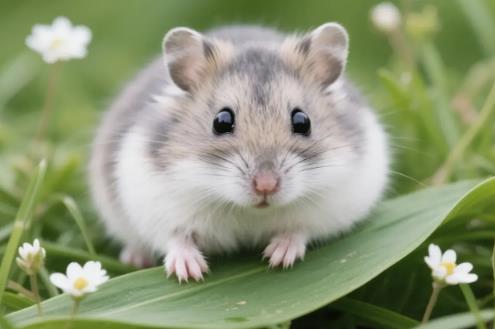To determine a hamster’s age, you need to observe multiple factors including size, fur, behavior, teeth, and reproductive traits—while also accounting for breed differences and health status. Below are detailed methods and steps, presented without tables:

1. Size and Weight: The Most Intuitive Initial Check
A hamster’s size and weight follow regular changes with age, and standard weight ranges vary by breed:
Juvenile hamsters (1–3 months): Small and round with short, stocky limbs and a tiny tail—overall resembling a "fluff ball." Campbell’s dwarfs (e.g., Campbell’s, Winter White) weigh around 20–40g, Roborovski dwarfs (e.g., Robo, Husky) around 15–25g, and Syrian hamsters (e.g., Golden Hamster) around 50–80g. They move slightly clumsily but are highly curious about new things.
Adult hamsters (4–12 months): Reach maximum size with a slender, muscular body and proportionate tail. Campbell’s dwarfs weigh 40–60g, Roborovski dwarfs 25–40g, and Syrians 100–150g. They are agile, adapt well to their environment, and follow fixed activity routines.
Senior hamsters (1 year+): May appear thin due to muscle loss, with a hunched back and slow movement. Weight drops by 10–20% compared to adulthood—for example, Campbell’s dwarfs may decrease to 35–50g. They sleep more, have weak hind legs, and often show a hunched posture.
Note: Size varies greatly by breed. Roborovski dwarfs, for instance, remain smaller than Campbell’s dwarfs even as adults, so breed-specific standards should be referenced when judging.
2. Fur Condition: Visual "Age Signals"
A hamster’s fur texture and color change gradually with age:
Juvenile hamsters: Fur is soft, dense, fluffy, and shiny with bright colors (e.g., Pudding hamsters are golden yellow as juveniles). It has no splits or breaks and feels smooth to the touch.
Adult hamsters: Fur lies sleek and close to the body with stable colors (e.g., Silver Fox hamsters have clear black dorsal stripes). It is neatly arranged and feels slightly stiffer.
Senior hamsters: Fur is dry and dull, may develop gray or white stray hairs (especially on the back and head), and is sparse and prone to shedding. The skin appears loose.
Tip: Sudden dryness or shedding may stem from illness or malnutrition, not just old age—prioritize checking health first.
3. Behavioral Traits: Dynamic "Age Indicators"
A hamster’s behavior patterns shift with age:
Juvenile hamsters: Highly curious, they climb and dig frequently, react sharply to food, are easily drawn to new toys, and enjoy interacting with humans.
Adult hamsters: Behavior is stable—they have a fixed sense of territory, follow regular routines (e.g., running on the wheel or eating at specific times), adapt well to familiar environments, and are gentler during interactions.
Senior hamsters: Move slowly, sleep more, and have reduced responses to stimuli (e.g., weak vocalizations, less frequent wheel-running). They may also show signs of aging like weak hind legs or a hunched back.
Key observation: A sudden shift from liveliness to excessive sleep may indicate environmental changes or health issues, not just age.
4. Teeth and Oral Condition: Detailed "Age Clues"
Hamsters’ teeth grow continuously, and age can lead to wear or abnormalities:
Juvenile hamsters: Teeth are short and white, with incisors about 3–5mm long. They show no signs of wear and make a crisp sound when gnawing hard objects.
Adult hamsters: Teeth are of moderate length (incisors around 5–7mm), may appear slightly yellow from using chew sticks, are neatly aligned, and have no breaks or deformities.
Senior hamsters: Teeth may be overgrown or undersized (due to insufficient gnawing), yellow or black (possibly from calcium loss or infection), and gnawing becomes labored. They may drool or have a decreased appetite.
Recommendation: Check your hamster’s teeth regularly. If overgrowth or breaks are found, provide chew toys (e.g., apple branches, chew sticks) and adjust their diet.
5. Reproductive Traits (Females Only): Special "Age Markers"
Female hamsters’ reproductive ability declines with age—estrous cycles and breeding history can assist in judgment:
Juvenile female hamsters (pre-sexually mature): Genitals are underdeveloped, the abdomen is flat, and there is no discharge. They reach sexual maturity around 1.5–2 months (Campbell’s dwarfs) or slightly later (Roborovski dwarfs).
Adult female hamsters (sexually mature): Experience 1–2 estrous cycles per month. During estrus, the vagina turns pink and secretes mucus, and they may actively groom themselves or allow male hamsters to approach.
Senior female hamsters (1 year+): Estrrous cycles become irregular or stop, reproductive ability declines (high risks for elderly breeding), the abdomen is loose, and they may develop age-related conditions like pyometra.
Reminder: Unspayed female hamsters over 1 year old require close health monitoring to avoid shortened lifespan due to breeding or illness.
6. Comprehensive Judgment and Precautions
Combine multiple traits: A single factor (e.g., size) may be misleading due to breed or individual differences—synthesize fur, behavior, teeth, and other features. For example, a small hamster with overgrown teeth may be a senior with insufficient gnawing, not a juvenile.
Account for health impacts: Illness or malnutrition can cause thinness or dry fur, leading to misjudgment as a senior. If a hamster shows abnormal aging signs (e.g., sudden weight loss), prioritize health checks.
Consider breed differences: Lifespan and size vary by breed (e.g., Roborovski dwarfs live 2–3 years, Syrians 2–2.5 years)—reference breed standards when judging.
Ask the source: If purchasing from a pet store or breeder, directly inquire about the hamster’s birth date for the most accurate age.
7. Quick Reference for Age Judgment
Easiest stage to identify: Adults (4–12 months) are the simplest to judge, with stable size and regular behavior.
Stages requiring careful observation: Juveniles and seniors need detailed comparison—e.g., juveniles’ fluffy fur vs. seniors’ dry fur, or juveniles’ lively behavior vs. seniors’ slowness.
No need to overthink: If exact age can’t be determined, prioritize health over precision. Provide a suitable living environment (e.g., 20–28℃ temperature, regular cage cleaning, balanced diet) instead of fixating on age.
